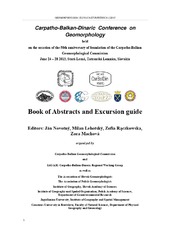| dc.description.abstract | Purpose of this study is to prepare slope instability map by using a spatial criteria in a landslide-
prone area of Belgrade suburban area. Landslide locations were detected from interpretation
of aerial images. Several factors were used for interpretation of landslide conditioning factors.
These factors are: slope, lithology, human impact, distance from rivers and streams, tectonic assembly,
NDVI (Normalized Difference Vegetation Index) calculated from Landsat 7 satellite images.
During last 35 years, in Belgrade urban and suburban area, more than 2000 landslides were
registered. Research area includes unstable slopes in the area of the gully, the total surface area of
1.4 km2. Research area is located near Sava, 20 km SW from Belgrade City centre, and it is very
close to biggest, deepest and the most investigated landslide in Belgrade area, named Umka. According
to Basic Geological Map (Filipović and Rodin 1976), whole area is built from marly and
carbonic clay, coal, diatomaceous earth and sand. Conformably over the Pannonian sediments lie
gray, yellowish and bluish marl clay. Average slope value of research area is 7.42°. Three groups
of faults are noted. Regional faults are NW-SE oriented. This group of faults is responsible for
gullies forming. Second detected group of faults is perpendicular to the first group. Some of this
ruptures are responsible for the occurrence of couple of landslides in this area. Third group includes
NNE-SSW oriented faults. Relation between the occurrences of slope instability to this
group of faults was not established. The biggest part of area of 0.8 km2 that was detected by analysing
of areal images is considered as a potential landslide, which means that it is not active landslide,
but there is big possibility, considering lithology, position and terrain slope, that could be
initiated with greater rainfall or other triggers. There are 10 active smaller landslides. Biggest of
them includes area of 0.3 km2. Two landslides that once were active, but not now, are detected.
They are in close vicinity of active landslides. Since the research area belongs to suburban area,
interpreted landslides do not make any threats to people or households. | en |

